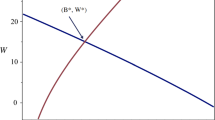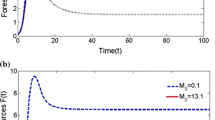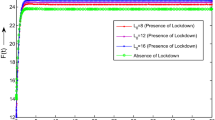Abstract
In this paper, a nonlinear mathematical model is proposed and analyzed to study the depletion of forest resources caused by population and the corresponding population pressure. It is assumed that the cumulative density of forest resources and the density of populations follow logistic models with prey–predator type nonlinear interaction terms. It is considered that the carrying capacity of forest resources decreases by population pressure, the main focus of this paper. A conservation model is also proposed to control the population pressure by providing some economic incentives to people, the amount of which is assumed to be proportional to the population pressure. The model is analyzed by using stability theory of differential equations and numerical simulation. The model analysis shows that as the density of population or population pressure increases, the cumulative density of forest resources decreases, and the resources may become extinct if the population pressure becomes too large. It is also noted that by controlling the population pressure, using some economic incentives, the density of forest resources can be maintained at an equilibrium level, which is population density dependent. The simulation analysis of the model confirms analytical results.






Similar content being viewed by others
References
Agarwal, M., Fatimaa, T., & Freedman, H. I. (2010). Depletion of forestry resource biomass due to industrialization pressure: A ratio-dependent mathematical model. Journal of Biological Dynamics, 4, 381–396.
Asongu, S. A., & Jingwa, B. A. (2012a). Population growth and forest sustainability in Africa. International Journal of Green Economics, 6(2), 145–165.
Asongu, S. A., & Jingwa, B. A. (2012b). The role of human development on deforestation in Africa: A modelling-based approach. International Journal of Green Economics, 6(4), 317–330.
Badola, R. (1998). Attitudes of local people towards conservation and alternatives to forest resources: A case study from the lower Himalayas. Biodiversity and Conservation, 7, 1245–1259.
Carvalho, G., Moutinho, P., Nepstad, D., Luciano Mattos, L., & Santilli, M. (2004). An amazon perspective on the forest-climate connection: Opportunity for climate mitigation, conservation and development?. Environment, Development and Sustainability, 6, 163–174.
Dhar, J. (2008). Population model with diffusion and supplementary forest resource in a two-patch habitat. Applied Mathematical Modelling, 32, 1219–1235.
Dubey, B. (1996). Modeling the effect of toxicant on forestry resources. Indian Journal of Pure and Applied Mathematics, 28(1), 1–12.
Dubey, B. (1997). Modelling the depletion and conservation of resources: Effect of two interacting population. Ecological Modelling, 101, 123–136.
Dubey, B. (2012). Modeling effects of two interacting populations on a renewable resource. Natural Resource Modeling, 25(2), 325–363.
Dubey, B., & Hussain, J. (2004). Models for the effect of environmental pollution on forestry resources with time delay. Nonlinear Analaysis: Real World Applications, 5, 549–570.
Dubey, B., & Narayanan, A. S. (2010). Modelling effects of industrialization, population and pollution on a renewable resource. Nonlinear Analaysis: Real World Applications, 11, 2833–2848.
Dubey, B., Sharma, S., Sinha, P. & Shukla, J. B. (2009). Modelling the depletion of forestry resources by population and population pressure augmented industrialization. Applied Mathematical Modelling, 33, 3002–3014.
Dubey, B., Upadhyay, R. K., & Hussain J. (2003). Effects of industrialization and pollution on resource biomass: A mathematical model. Ecological Modelling, 167, 83–95.
Freedman, H. I., & So, J. W. H. (1985). Global stability and persistence of simple food chains. Mathematical Biosciences, 76, 69–86.
Garcia-Montiel, D. C., & Scatena, F .N. (1994). The effect of human activity on the structure and composition of a tropical forest in Puerto Rico. Forest Ecology and Management, 63, 57–78.
Gakkhar, S., & Sahani, S. K. (2009). A model for delayed effect of toxicant on resource-biomass system. Chaos, Solitons & Fractals, 40, 912–922.
Hüttl, R. F., & Wisniewski, J. (1987). Fertilization as a tool to mitigate forest decline associated with nutrient deficiencies. Water, Air, and Soil Pollution, 33, 265–276.
Huang, W., Wilkes, A., Sun, X., & Terheggen, A. (2012). Who is importing forest products from Africa to China? An analysis of implications for initiatives to enhance legality and sustainability. Environment, Development and Sustainability. doi:10.1007/s10668-012-9413-1.
Misra, A. K., & Lata, K. (2013). Modeling the effect of time delay on the conservation of forestry biomass. Chaos, Solitons & Fractals, 46, 1–11.
Naresh, R., Sundar, S., & Shukla, J. B. (2006). Modeling the effect of an intermediate toxic product formed by uptake of a toxicant on plant biomass. Applied Mathematics and Computation, 182, 151–160.
Ndoye, O., & Tieguhong, J. C. (2004). Forest resources and rural livelihoods: The conflict between timber and non-timber forest products in the Congo Basin. Scandinavian Journal of Forest Research, 19(Suppl. 4), 1–9.
Percy, K. E., & Ferretti, M. (2004). Air pollution and forest health: Toward new monitoring concepts. Environmental Pollution, 130, 113–126.
Repetto, R., & Holmes, T. (1983). The role of population in resource depletion in developing countries. Population and Development Review, 9(4), 609–632.
Ritter, E., & Dauksta, D. (2012). Human–forest relationships: Ancient values in modern perspectives. Environment, Development and Sustainability. doi:10.1007/s10668-012-9398-9.
Shukla, J. B., Agrawal, A. K., Sinha, P., & Dubey, B. (2003). Modeling effects of primary and secondary and toxicants on renewable resources. Natural Resource Modeling, 16(1), 99–120.
Shukla, J. B., & Dubey, B. (1996). Effect of changing habitat on species: Application to Keoladeo National Park, India. Ecological Modelling, 86, 91–99.
Shukla, J. B., & Dubey, B. (1997). Modelling the depletion and conservation of forestry resource: Effects of population and pollution. Journal of Mathematical Biology, 36, 71–94.
Shukla, J. B., Freedman, H. I., Pal, V. N., Misra, O. P., Agarwal, M., & Shukla, A. (1989). Degradation and subsequent regeneration of a forestry resource: A mathematical model. Ecological Modelling, 44, 219–229.
Shukla, J. B., Lata K., & Misra A. K. (2011). Modeling the depletion of a renewable resource by population and industrialization: Effect of technology on its conservation. Natural Resource Modeling, 24(2), 242–267.
Acknowledgments
Authors are thankful to the handling editor and both the referees for their useful suggestions, which have improved the quality of this paper. Second author thankfully acknowledges the Council of Scientific and Industrial Research, New Delhi, India for the financial assistance in the form of Senior Research Fellowship (09/013(0267)/2009-EMR- I).
Author information
Authors and Affiliations
Corresponding author
Appendices
Appendix 1: Proof of theorem 1
Linearizing the model system (1) about E *3 by using the following transformations
where b, n and p are small perturbations around the equilibrium E *3 . Now using the following positive definite function:
(where m 1 and m 2 are some positive constants to be chosen appropriately). Differentiating above equation with respect to t along the solutions of linearized system of (1), we get
Choosing \(m_1= \frac{1}{\pi},\;\frac{{\hbox{d}}V}{{\hbox{d}}t}\) simplified as:
We note that \(\frac{{\hbox{d}}V}{{\hbox{d}}t}\) is negative definite under condition (8), proving the theorem.
Appendix 2: Proof of theorem 2
To prove this theorem, we consider the following positive definite function.
where k 1 and k 2 are positive constants to be chosen appropriately. Now differentiating ‘W’ with respect to ‘t’ along the solutions of model system (1),
Now using model system (1) and making a simple algebraic manipulation, we get
Now choosing \(k_1 = \frac{1}{\pi}\) and using region of attraction, we see that \(\frac{{\hbox{d}}W}{{\hbox{d}}t}\) will be negative definite inside the region of attraction provided that condition (9) is satisfied.
Rights and permissions
About this article
Cite this article
Misra, A.K., Lata, K. & Shukla, J.B. Effects of population and population pressure on forest resources and their conservation: a modeling study. Environ Dev Sustain 16, 361–374 (2014). https://doi.org/10.1007/s10668-013-9481-x
Received:
Accepted:
Published:
Issue Date:
DOI: https://doi.org/10.1007/s10668-013-9481-x




